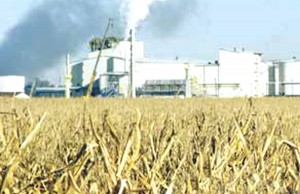Government is currently wooing additional investors in an effort to consolidate what Director of the Institute of Applied Science and Technology (IAST) Suresh Narine has told Stabroek Business is the Institute’s “already very successful initiatives in the biofuels sector.”

Narine, who holds an Associate professorship in Food Science at the University of Alberta told Stabroek Business told that the work of the IAST was currently centred around bio-fuels, agro-energy, indigenous materials, bio-prospecting and analytical services. He said that in the area of biofuels the IAST had taken a very successful initiative “all the way from ideation to commercialization which would not have been possible ten years ago because the price of fuel was too high.”
The IAST’s biofuels programme commenced in 2006 as a laboratory programme designed to examine ways of converting available feedstock into biofuels. Narine told Stabroek Business that as part of the project the IAST had designed a unique pilot plant to convert large quantities of oils available in Guyana into biofuels.
Narine told Stabroek Business that the IAST had since been successful in persuading an overseas investor to invest in a commercial venture using that plant. The investor has also acquired the assets of the oil palm plant at Wauna for bio-diesel production.
Over the past eighteen months the project has supplied the Regional administration at Mabaruna with between 150 and 200 barrels of biodiesel per month which, according to Narine, is used to power its generator and its vehicles. Some of the fuel is also sold to the Guyana Water Inc.
The current expansion of the Wauna Estate is currently underway and Narine estimates that when this is completed the project will supply around 5 per cent of the country’s diesel needs.
Meanwhile, Narine told Stabroek Business that while Guyana’s land and water resources provide the potential for the country to reap immediate-term economic benefits from any major agricultural expansion programme, long-term economic viability depended on Guyana’s ability to address its energy security.
“As long we can sustain the Grow More Food campaign and ensure that we are addressing our quality control and safety issues we can sustain a measure of success for about three years. However, we must begin to address our energy needs. “Forty per cent of GDP is no joke.”
“The best thing that can happen to Guyana is for us to start pumping oil. If we can pump and refine petroleum it is the most brilliant hope for the development of the country. At the same time Guyana is one of the few countries in the world with enough arable land per capita to pursue biofuels as a viable option.
If we were to start pumping petroleum and at the same time we had a viable biofuels industry we would be in a position to utilize our biofuels at home and export our petroleum.” Narine said.
And according to the IAST Director the current thrust to maximize food production for local and export consumption must, of necessity, take account of training, standards and regulation and of the need for the creation of an investment conducive to attracting and sustaining overseas investments in the agricultural sector, ”We need qualified people in order to grow food and make fuel, we need to develop laboratories to police safety standards and regulations and we need to create a portfolio to address the issue of investment in agriculture. “
And according to Narine local institutions like the Institute of Applied Science and Technology (IAST), the National Agricultural Research Institute (NARI) and the University of Guyana had critical supporting roles to play in the quest to increase food production.
“There is a great role for these institutions to play in transforming our economy from one that is built around commodities that are poorly produced, poorly processed or barely processed and poorly marketed into a bio-economy.” Narine said.






